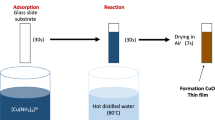Abstract
Copper iodide (CuI) thin film has been fabricated by controlled potential anodization of copper (Cu) in the potassium iodide (KI) electrolyte. Thin film X-ray diffraction investigations confirm the growth of highly crystalline and pristine γ-CuI thin films at lower anodization potentials. In contrast, the films prepared at higher anodization potentials show the mixed phase with iodine and less crystalline nature. The simultaneous rapid electrooxidation of the Cu and iodide at higher positive potentials results in the growth of iodine crystals with CuI thin films. In particular, the surface morphology of the thin film micro/nanocrystals is tuned by the anodization potentials and the extent of iodine formation at the anode. The CuI thin film deposited at lower potentials exhibits a stable cathodic photocurrent response (−36 to −40 μA cm−2) in 0.5 M Na2SO4 medium. The photoelectrochemical hydrogen evolution studies illustrate the enhanced activity of p-type γ-CuI than the bare Cu electrode in acidic conditions. The systematic anodic shift in the onset hydrogen evolution potential depends on the film deposition potentials.









Similar content being viewed by others
References
Krol RVD, Graetzel M (2012) Photoelectrochemical hydrogen production. Springer Science+Business Media 102:3–11
Graetzel M (2001) Photoelectrochemical cells. Nature 414:338–344
Huang Q, Ye Z, Xiao X (2015) Recent progress in photocathodes for hydrogen evolution. J Mater Chem A3:15824–15837
Shin HC, Dong J, Liu M (2003) Nanoporous structures prepared by an electrochemical deposition process. Adv Mater 15:1610–1614
Su Z, Zhou W, Jiang F, Hong M (2012) Anodic formation of nanoporous and nanotubular metal oxides. J Mater Chem 22:535–544
Mor GK, Varghese OK, Paulose M, Shankar K, Grimes CA (2006) A review on highly ordered, vertically oriented TiO2 nanotube arrays: fabrication, material properties, and solar energy applications. Sol Energy Mater Sol Cells 90:2011–2075
Das S, Choi J, Alford TL (2015) P3HT:PC61 BM based solar cells employing solution processed copper iodide as the hole transport layer. Sol Energy Mater Sol Cells 133:255–259
Mohamed SA, Gasiorowski J, Hingerl K, Zahn DRT, Scharber MC (2015) CuI as versatile hole-selective contact for organic solar cell based on anthracene-containing PPE–PPV. Sol Energy Mater Sol Cells 143:369–374
Sharma B, Rabinal MK (2013) Ambient synthesis and optoelectronic properties of copper iodide semiconductor nanoparticles. J Alloys Compd 556:198–202
Christians JA, Fung RCM, Kamat PV (2014) An inorganic hole conductor for organo-lead halide perovskite solar cells. Improved hole conductivity with copper iodide. J Am Chem Soc 136:758–764
Lee J-H, Leem D-S, Kim J-J (2008) High performance top-emitting organic light-emitting diodes with copper iodide-doped hole injection layer. Org Electron 9:805–808
Sirimanne PM, Soga T, Jimbo T (2003) Identification of various luminescence centers in CuI films by cathodoluminescence technique. J Lumin 105:105–109
Perera VPS, Tennakone K (2003) Recombination processes in dye-sensitized solid-state solar cells with CuI as the hole collector. Sol Energy Mater Sol Cells 79:249–255
Bulakhe RN, Shinde NM, Thorat RD, Nikam SS, Lokhande CD (2013) Deposition of copper iodide thin films by chemical bath deposition (CBD) and successive ionic layer adsorption and reaction (SILAR) methods. Curr Appl Phys 13:1661–1667
Johan MR, Si-Wen K, Hawari N, Aznan NAK (2012) Synthesis and characterization of copper (I) iodide nanoparticles via chemical route. Int J Electrochem Sci 7:4942–4950
Chaudhuri TK, Basu PK, Patra AB, Saraswat RS, Acharya HN (1990) A chemical method for preparing copper iodide thin films. Jpn J Appl Phys 29(L):352–354
Hsiao G, Anderson MG, Gorer S, Harris D, Penner RM (1997) Hybrid electrochemical/chemical synthesis of supported, luminescent semiconductor nanocrystallites with size selectivity: copper (I) iodide. J Am Chem Soc 119:1439–1448
Hsu C-T, Chung H-H, Kumar AS, Zen J-M (2005) Novel preparation and photoelectrochemical properties of g-CuI semiconductor nanocrystallites on screen-printed carbon electrodes. Electroanalysis 17:1822–1827
Kanga H, Liua R, Chena K, Zhengb Y, Xua Z (2010) Electrodeposition and optical properties of highly oriented γ-CuI thin films. Electrochim Acta 55:8121–8125
Huang H, Chien D, Huang G, Chen P (2012) Electrochemical preparation of photoelectrochemically active CuI thin films from room temperature ionic liquid. Electrochim Acta 65:204–209
Amalina MN, Rusop M (2013) Investigation on the I2:CuI thin films and its stability over time. Microelectron Eng 108:106–111
Acknowledgments
The authors gratefully acknowledge the financial aid (No. CS190) from SERB-DST India.
Author information
Authors and Affiliations
Corresponding author
Rights and permissions
About this article
Cite this article
Vishwanath, R.S., Kandaiah, S. Electrochemical preparation of crystalline γ-CuI thin films through potential-controlled anodization of copper and its photoelectrochemical investigations. J Solid State Electrochem 20, 2093–2102 (2016). https://doi.org/10.1007/s10008-016-3218-3
Received:
Revised:
Accepted:
Published:
Issue Date:
DOI: https://doi.org/10.1007/s10008-016-3218-3




